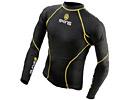
Recently on Cyclingnews.com |
Tech feature: May 1, 2009
Training: Do you need that kind of pressure?

|
If you're looking to squeeze a little extra performance from your body, it's likely you've already come across compression garments. The many studies into their benefits have drawn wildly different conclusions, so Cycling Plus' Nick Morgan finds out what's solid fact and what's still unproven.
The theory
The main point of compression garments is to apply pressure to the body and thus improve your blood's circulation. Specifically, it's claimed that compression garments increase the flow of de-oxygenated (venous) blood back to the heart.
This doesn't improve performance directly, but some scientists believe the increased flow of blood may cause the heart's muscles to stretch to accommodate the extra returned blood, which should result in increased output.
Also, the pressure is expected to aid your body's lactate removal, hastening your recovery after hard exercise.
Dual benefit?

|
Unfortunately, as simple as the theory is to grasp, it's equally hard to prove. Elements of it are well established, though. For example, a study at the Royal Free Hospital in London found evidence compression stockings did indeed increase blood return to the heart, but didn't investigate if this had a knock-on effect on cardiac output.
Elsewhere, researchers from Osaka City University found some evidence of improvement in cardiac output from wearing compression stockings, but their conclusions must be treated cautiously for two reasons. Firstly, they measured cardiac output at rest. Secondly, many of the subjects reported a high level of discomfort while they were wearing the stockings.
Which highlights a problem: there's no current standard for how much pressure a compression garment should apply. Similarly, relatively few studies have looked at the garments' effects during exercise.
A numbers game
Share your experience
|
That was until a new study from Central Queensland University in Australia set out to look for concrete benefits. Aaron Scanlan and his team measured the effects of wearing lower-body compression garments in a cycling time trial. Using traditional statistics, they found no evidence of a benefit in the categories measured. Yet this isn't quite the end of the story.
"There's a question as to whether traditional statistics are adequate for sports science research," says Scanlan. "Sometimes a minor improvement won't show statistical significance, but a small change could be absolutely crucial to a top-level athlete."
As a result, Scanlan also applied a technique called Magnitude-Based Inferences to the data. Using this method he was able to show that power output and anaerobic threshold were slightly improved when wearing compression garments and the efficiency of the muscle oxygenation process was also marginally better. These findings have persuaded Scanlan that compression garments should not be dismissed and that further research is necessary.

|
Evidence for recovery benefits is equally circumstantial, but compelling. In a 2007 study at Massey University in New Zealand researchers asked subjects to record the soreness in their legs the day after completing a steady 10km run, both with and without compression socks. When wearing the socks, two of the 14 subjects reported soreness the following day; without the socks, that rose to all but one.
"It's true that recovery responses with the use of compression garments have been much more positive than performance responses," says Scanlan. "But the perception of muscle soreness is largely measured by questionnaires, in which the placebo effect could be at play.
"The only real practical advice I can give at the moment is to ignore the results on the use of compression garments and try them out," he added. "If they feel good to wear during cycling, then wear them during cycling, and if they feel good during recovery, wear them during recovery."
Photography
For a thumbnail gallery of these images, click here
Images by James Huang/Cyclingnews.com
- There's plenty of claims over compression garments but their actual impact requires more study, according to Aaron Scanlan.
Images by Skins
- Skins is well known for its compression garments.
Images by Casey Gibson/www.cbgphoto.com
- Tight tights? Cadel Evans (Australia) isn't wearing a compression garment here, but any tighter and he'd be kissing goodbye the idea of having kids!
Images by Hilly
- Hilly's socks claim improved recovery rate if worn post exercise and increased blood flow helps to clear lactic acid.

